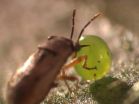(Press-News.org) RIVERSIDE, Calif. — Contrary to what police, politicians and the public believe about the effectiveness of California's three-strikes law, research by a University of California, Riverside criminologist has found that the get-tough-on-criminals policy voters approved in 1994 has done nothing to reduce the crime rate.
In a rigorous analysis of crime in California and the nation, sociology professor Robert Nash Parker determined that crime has been decreasing at about the same rate in every state for 20 years, regardless of whether three-strikes policies are in place or not.
Robert Nash Parker
Parker's findings appear in the paper "Why California's 'Three Strikes' Fails as Crime and Economic Policy, and What to Do," published recently in the California Journal of Politics and Policy. The online journal publishes cutting-edge research on national, state and local government, electoral politics, and public policy formation and implementation.
California's three-strikes law imposes a minimum sentence of 25 years to life on the third felony conviction for offenders with prior serious or violent felony convictions. Approximately 23,000 individuals have been incarcerated under three strikes. Proposition 36, on the Nov. 6 ballot, would impose the life sentence only when the new felony conviction is serious or violent.
"There is not a single shred of scientific evidence, research or data to show that three strikes caused a 100 percent decline in violence in California or elsewhere in the last 20 years," Parker said, adding that the downward trend began two years before the California law was enacted.
Violent crime decreased by about the same rate in California and other three-strikes states as well as those without similar legislation, Parker found. Other researchers who have examined crime in California cities and counties since the legislation took effect have reached similar conclusions, he noted.
"Three-strikes is not driving the trend in violent crime," Parker said.
Nor is threat of a life sentence for repeat offenders a deterrent, he added, citing the work of other researchers on offender behavior which found that neither prior arrests nor prior convictions had any impact on an individual offender's perception of being caught, suggesting that three-strikes laws are not the deterrent that law enforcement officials, politicians and the public would like to believe.
If three-strikes laws do not account for the significant decline in violent crime, what does?
Alcohol consumption and unemployment, Parker believes.
Citing earlier research, analyses of 60 years of national crime data investigated alcohol consumption, unemployment, poverty, proportion of young people in the population, average earnings, welfare payments, and U.S. involvement in war as possible influences on crime.
Parker and Wisconsin researcher Randi Cartmill determined that when alcohol consumption increases, violent crime follows one or two years later, and that when alcohol consumption decreases, the crime rate drops one to two years later.
"Alcohol consumption peaked nationally in 1982 and has declined significantly and steadily ever since," Parker said. "Beer and spirits consumption are the two most consistent predictors of homicide."
Unemployment is a lesser, but influential factor, in the rise and fall of crime rates, they found.
"These findings are consistent with a growing body of research that demonstrates the important relationship between alcohol and violence in the U.S.," Parker said. "There is no justification for continuing three strikes from a violence prevention point of view. In fact, this analysis suggests that alcohol policy designed to reduce overall consumption in California may be more effective at reducing violence than three strikes and/or other criminal justice policy initiatives."
While three strikes has been ineffective in reducing the crime rate, Parker says, the law has contributed significantly to California's serious budget woes, which now also impacts county jails as inmates are transferred from state prisons to local jurisdictions to comply with court orders to reduce overcrowding — a policy known as "realignment."
Incarcerating so many Californians has shifted state spending priorities, he points out. In 1985, spending on higher education in the state accounted for about 11 percent of the budget; prisons consumed 4 percent of state spending. By 1993, spending for each accounted for about 6 percent of the budget. By 2010, higher education spending accounted for less than 6 percent of the state budget while prison spending consumed nearly 10 percent. K-12 budgets and spending on health and welfare programs have eroded substantially since the implementation of three strikes as well.
The state spends approximately $57,500 to house one inmate for one year, according to the California State Auditor.
Leaving three strikes intact while pursuing the policy of realignment could result in significant financial problems in the near future for both state and local governments, Parker cautioned.
"California should give up its addiction to the all-you-can-eat buffet of imprisonment, the result of which has been to undermine the financial health of the state, weaken the quality of education at all levels, and force the state to make draconian cuts in programs that enhance and benefit the lives of its residents in exchange for the mistaken idea that public safety was the result," Parker concluded. "The bottom-line result of three strikes has been an almost unbearable financial burden that looms in the future despite current efforts, and which will only be resolved when the pipeline of over-punishment is finally shut down."
INFORMATION:
Evidence does not support 3-strikes law as crime deterrent
UC Riverside criminologist finds that decline in alcohol consumption is most responsible for decreasing crime rate
2012-10-16
ELSE PRESS RELEASES FROM THIS DATE:
New radiation treatment significantly increases survival rate
2012-10-16
Arlington, Va. — A novel drug that mimics a naturally occurring molecule found in coffee and blueberries has been developed to treat radiation exposure. Charles R. Yates, Pharm.D., Ph.D., and colleagues Duane Miller, Ph.D., and Waleed Gaber, Ph.D., from the University of Tennessee Health Science Center and Baylor College of Medicine, show that application of this drug, starting 24 hours after radiation exposure, increases survival in animal models by three-fold compared to placebo.
Their work, which is funded through an NIH grant from the National Institute for Allergy ...
New dissolvable oral strip provides instant pain relief for burns
2012-10-16
Arlington, Va. — A dissolvable oral strip has been developed to immediately relieve pain from burns caused by ingestion of hot foods and liquids, such as coffee, pizza, and soup. This research is being presented at the 2012 American Association of Pharmaceutical Scientists (AAPS) Annual Meeting and Exposition, the world's largest pharmaceutical sciences meeting, in Chicago, Ill., on Oct. 14 – 18.
Lead researcher Jason McConville, Ph.D., and colleagues from University of Texas at Austin, designed the strip for controlled delivery of a local anesthetic, benzocaine, and ...
Great apes, small numbers
2012-10-16
Sumatran orangutans have undergone a substantial recent population decline, according to a new genetic study, but the same research revealed the existence of critical corridors for dispersal migrations that, if protected, can help maintain genetic diversity and aid in the species' conservation.
One of two species of orangutans, the Sumatran orangutan is classified as "critically endangered" by the IUCN Red List. Once widespread on the island of Sumatra, only an estimated 6,600 individuals remain, restricted to small forest patches on the northern tip of the island. Recent ...
Novel insights into the physical basis of sickle cell disease could lead to better treatments
2012-10-16
Sickle cell disease—the most common inherited blood disorder in the United States—causes red blood cells to distort into a crescent shape and block small blood vessels. New insights into how these abnormal cells disrupt circulation could lead to more effective treatment strategies, as revealed by a study published by Cell Press in the October 17th issue of Biophysical Journal.
"Sickle cell disease entails a central mechanical component, since the circulation gets blocked," explains senior study author Frank Ferrone of Drexel University. "We now finally understand how ...
Prion protein hints at role in aiding learning and memory
2012-10-16
Scientists from the University of Leeds have found that the protein called prion helps our brains to absorb zinc, which is believed to be crucial to our ability to learn and the wellbeing of our memory.
The findings published today (Tuesday 16 October) in Nature Communications show that prion protein regulates the amount of zinc in the brain by helping cells absorb it through channels in the cell surface. It is already known that high levels of zinc between brain cells are linked with diseases such as Alzheimer's and Parkinson's.
Professor Nigel Hooper from the University's ...
Boreal forest bends to development but there is a breaking point
2012-10-16
(Edmonton) Northern Alberta's boreal forest shows a surprising resiliency to human intrusion, but University of Alberta researchers warn the landscape has a definite breaking point.
The U of A research team led by graduate student Stephen Mayor found that up to a certain point plant life in the boreal forest responded to intrusions such as roadways and farm fields by actually increasing its biodiversity.
The researchers, counted plant species in sites across the whole of northern Alberta, an area larger than Germany. Then satellite and aerial photos were used to ...
Study advances understanding of volcanic eruptions
2012-10-16
Volcanic eruptions vary from common, small eruptions that have little impact on humans and the environment to rare, large-to-gigantic eruptions so massive they can threaten civilizations.
While scientists don't yet fully understand the mechanisms that control whether an eruption is large or small, they do know that eruptions are driven by the rapid expansion of bubbles formed from water and other volatile substances trapped in molten rock as it rises beneath a volcano. The mechanism is much the same as that involved in shaking a bottle of a carbonated drink and then ...
2-gene test predicts which patients with heart failure respond best to beta-blocker drug
2012-10-16
Tampa, FL (Oct. 16, 2012) -- A landmark paper identifying genetic signatures that predict which patients will respond to a life-saving drug for treating congestive heart failure has been published by a research team co-led by Stephen B. Liggett, MD, of the University of South Florida.
The study, drawing upon a randomized placebo-controlled trial for the beta blocker bucindolol, apprears this month in the online international journal PLoS ONE. In addition to Dr. Liggett, whose laboratory discovered and characterized the two genetic variations, Christopher O'Connor, ...
Green leaf volatiles increase plant fitness via biocontrol
2012-10-16
This press release is available in German.
To solve the acute, global problem of securing food resources for a continuously growing population, we must work constantly to increase the sustainability and effectiveness of modern agricultural techniques. These efforts depend on new insights from plant ecology, particularly from work on native plants that grow in the primordial agricultural niche. Based on field studies on wild tobacco plants in the Great Basin Desert, Utah, USA, researchers of the Max Planck Institute for Chemical Ecology in Jena, Germany, demonstrated that ...
An extremely brief reversal of the geomagnetic field, climate variability and a super volcano
2012-10-16
An extremely brief reversal of the geomagnetic field, climate variability and a super volcano
41,000 years ago, a complete and rapid reversal of the geomagnetic field occured. Magnetic studies of the GFZ German Research Centre for Geosciences on sediment cores from the Black Sea show that during this period, during the last ice age, a compass at the Black Sea would have pointed to the south instead of north. Moreover, data obtained by the research team formed around GFZ researchers Dr. Norbert Nowaczyk and Prof. Helge Arz, together with additional data from other studies ...
LAST 30 PRESS RELEASES:
Making lighter work of calculating fluid and heat flow
Normalizing blood sugar can halve heart attack risk
Lowering blood sugar cuts heart attack risk in people with prediabetes
Study links genetic variants to risk of blinding eye disease in premature infants
Non-opioid ‘pain sponge’ therapy halts cartilage degeneration and relieves chronic pain
AI can pick up cultural values by mimicking how kids learn
China’s ecological redlines offer fast track to 30 x 30 global conservation goal
Invisible indoor threats: emerging household contaminants and their growing risks to human health
Adding antibody treatment to chemo boosts outcomes for children with rare cancer
Germline pathogenic variants among women without a history of breast cancer
Tanning beds triple melanoma risk, potentially causing broad DNA damage
Unique bond identified as key to viral infection speed
Indoor tanning makes youthful skin much older on a genetic level
Mouse model sheds new light on the causes and potential solutions to human GI problems linked to muscular dystrophy
The Journal of Nuclear Medicine ahead-of-print tip sheet: December 12, 2025
Smarter tools for peering into the microscopic world
Applications open for funding to conduct research in the Kinsey Institute archives
Global measure underestimates the severity of food insecurity
Child survivors of critical illness are missing out on timely follow up care
Risk-based vs annual breast cancer screening / the WISDOM randomized clinical trial
University of Toronto launches Electric Vehicle Innovation Ontario to accelerate advanced EV technologies and build Canada’s innovation advantage
Early relapse predicts poor outcomes in aggressive blood cancer
American College of Lifestyle Medicine applauds two CMS models aligned with lifestyle medicine practice and reimbursement
Clinical trial finds cannabis use not a barrier to quitting nicotine vaping
Supplemental nutrition assistance program policies and food insecurity
Switching immune cells to “night mode” could limit damage after a heart attack, study suggests
URI-based Global RIghts Project report spotlights continued troubling trends in worldwide inhumane treatment
Neutrophils are less aggressive at night, explaining why nighttime heart attacks cause less damage than daytime events
Menopausal hormone therapy may not pose breast cancer risk for women with BRCA mutations
Mobile health tool may improve quality of life for adolescent and young adult breast cancer survivors
[Press-News.org] Evidence does not support 3-strikes law as crime deterrentUC Riverside criminologist finds that decline in alcohol consumption is most responsible for decreasing crime rate



